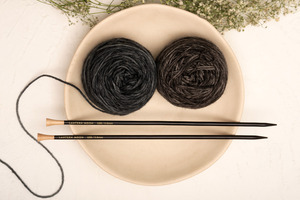Learn to Knit Through Back Loop (Ktbl)
الجسم
Learning to knit through the back loop is a useful technique in knitting that creates a twisted stitch. It is commonly used to add texture and interest to patterns, or when specifically instructed in a pattern. Knitting through the back loop (KTBL) can be done with any of the regular knitting needles. If you are working on flat patterns, you can knit with single-pointed needles or circulars back and forth. If you are knitting in the round, with double pointed needles (DPNs) or circular needles, you still can knit through the back loop.
Here's a step-by-step guide on how to knit through the back loop:
- Start with the working yarn at the back of the work and the right-hand knitting needle inserted into the next stitch as if you were going to knit it regularly (through the front loop).
- Instead of inserting the needle from left to right through the front leg of the stitch, you will insert it from right to left through the back leg of the stitch. The back leg is the loop of the stitch that is farthest from you.
- With the needle inserted through the back leg of the stitch, bring the working yarn around the needle as if to knit.
- Use the right-hand needle to pull the loop of the working yarn through the back leg of the stitch, just like you would in a regular knit stitch.
- Slip the original stitch off the left-hand needle and complete a knit through the back loop (ktbl) stitch.
- Continue knitting the next stitches following the pattern instructions or until you've completed the desired number of ktbl stitches.
Remember to pay attention to the orientation of the stitches on the left-hand needle as you work, especially when knitting subsequent rows. Knitting through the back loop can twist the stitch, and if you're not careful, it may affect the appearance of the fabric.
It's a good idea to practice knitting through the back loop on a swatch or sample piece before using it in a project. This way, you can familiarize yourself with the technique and ensure you're comfortable executing it correctly.
Difference between regular knit stitches and KTBL stitches
Knit and knit through back loop stitches (KTBL) look similar but they are also visibly different when you look at your knitted fabric. Regular knit stitch forms a little “V” while the knit through the back loop almost looks like an “X”. The yarn strand appears to be twisted counterclockwise. It looks like a twisted stockinette pattern but has a denser fabric and is not as complicated.
PTBL aka purl through the back loop is also a similar knitting technique where you work with the purl stitch. These stitches also have the same uses as KTBL. These are particularly useful for a knitting pattern with purl stitches or when you work with a garter stitch pattern with circular knitting needles. Garter, generally is a pattern or all row stitches but when you are working in the round with circular needles it becomes alternative rounds of knit and purl stitches.
Why KTBL is useful?
KTBL is an easy way to twist a knitting stitch. It needs more yarn than the regular knit stitch and is also tighter. It will create a textured effect on the knitted fabric.
Here are a couple of uses of KTBL:
Fixing a Hole caused by a Yarn over - When you pick up stitches (for the gusset of socks), the best option is to knit across the picked-up stitches through the back loop. You’ll be able to avoid any pesky holes and have a beautiful textured stitch pattern in its place.
Make 1X1 Rib Stitch Pop – When the rib stitches contract too much, knitting through the back loop makes the stitch pattern pop and look good. In fact, it will be a bit less stretchy but it will add more structure and stability to the fabric.
Untwisting Twisted Stitches - A clever way to fix mistakes is to knit through the back loop. When you knit through the stitches through the back loop, you intentionally twist the stitches fixing the twisted stitch.
Knitting Mini Cables - If you want to knit super small mini cables, knit every knit stitch through the back loop. As they pop, they will have a textured cable effect but then you have a limit to the number of cable stitches. One such special technique comes from Bavaria, the biggest state in Germany where the traditional costumes involve incredibly elaborate stockings (knitted with 2.00 mm needles with cables that do not involve special cable needles or techniques). Almost all of these knitting patterns involve KTBL stitches. The knitting techniques beautifully create diamonds or cables and other textured effects.
Anyway, that’s everything about the technique of knitting through the back loop. With premium knitting needles from the Lantern Moon Collection expand your craft repertoire. Handcrafted from smooth ebony wood each tool and accessory is made by skilled artisans who have the knowledge of centuries’ of craftsmanship. Each knitting needle and crochet hook is a treasure to be cherished for generations. The interchangeable knitting needle sets are a complete kit for knitters to explore the beauty of the craft!
Happy knitting!
Source by- https://www.zupyak.com/p/3719693/t/learn-to-knit-through-back-loop-ktbl














تعليقات